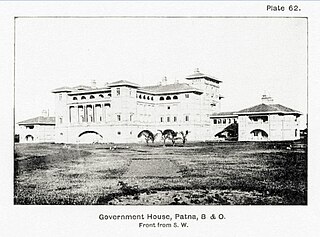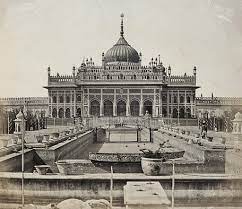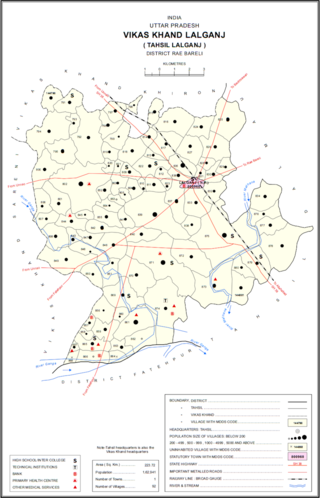
The Rashtrapati Bhavan is the official residence of the President of India at the western end of Rajpath, Raisina Hill, New Delhi, India. It was formerly known as Viceroy's House and constructed during the zenith of British Empire. Rashtrapati Bhavan may refer to only the 340-room main building that has the president's official residence, including reception halls, guest rooms and offices, also called the mansion; it may also refer to the entire 130-hectare (320-acre) Presidential Estate that additionally includes the presidential gardens, large open spaces, residences of bodyguards and staff, stables, other offices and utilities within its perimeter walls. In terms of area, it is the 2nd largest residence of any head of state in the world after Quirinal Palace in Italy. The other presidential homes are the Rashtrapati Nilayam in Hyderabad, Telangana and The Retreat Building in Shimla, Himachal Pradesh.

Raj Bhavan, Karnataka is the official residence of the governor of Karnataka located in Bengaluru city, in the State of Karnataka, India. Constructed in the late 18th century.
Satna is a city in the Indian state of Madhya Pradesh. It serves as the headquarters of Satna district. It is 7th largest city and 8th most populous city of the state. The city is 500 km east of the state capital Bhopal. The city is distributed over a land area of 111.9 square kilometres.

Major-General Claude Martin was a French army officer who served in the French and later British East India companies in colonial India. Martin rose to the rank of major-general in the British East India Company's Bengal Army. Martin was born in Lyon, France, into a humble background, and was a self-made man who left a substantial lasting legacy in the form of his writings, buildings and the educational institutions he founded posthumously. There are now ten schools named after him, two in Lucknow, two in Calcutta and six in Lyon. The small village of Martin Purwa in India was also named after him.

La Martinière College is a private educational institution for the upper elite class located in Lucknow, the capital of the Indian state of Uttar Pradesh. The college consists of two schools on different campuses for boys and girls. La Martinière College was founded in 1845 and La Martinière Girls' College was established in 1869. The Boys' College is the only school in the world to have been awarded royal battle honours for its role in the defence of Lucknow during the Indian Rebellion of 1857. The two Lucknow colleges are part of the La Martinière family of schools founded by the French adventurer Major General Claude Martin. There are two La Martinière Colleges in Kolkata and three in Lyon. La Martinière provides a liberal education and the medium of instruction is the English language. The schools cater for pupils from the ages of five through to 17 or 18, and are open to children of all religious denominations, the boys' school has a Chapel, a Hindu Temple and a Mosque on its campus and has remained a non-denominational school since its inception, unlike the two La Martiniere Schools in Calcutta which are Christian schools, controlled by the Anglican Church of North India. The schools have day scholars and residence scholars (boarders).

Raj Bhavan is the official residence of the governor of West Bengal, located in Kolkata(the capital of the Indian state West Bengal). Built in 1803, it was known as Government House before Indian independence.
Mohammed Usman Arif was a leader of Indian National Congress. Born on 5 April 1923 in Bikaner in the Indian state of Rajasthan, he did his graduation from Dungar College, Bikaner and then completed his master's degree and LLB from Aligarh Muslim University. Later on he joined the Indian National Congress and rose to become the President of Rajasthan state unit of the party in 1980. He was elected to Rajya Sabha and was a minister in the Government of India from 1980 to 1984. He was also associated with Rajasthan State Haj Committee and Rajasthan Board of Muslim Waqfs. He was governor of Uttar Pradesh state from 31 March 1985 to 11 February 1990. He died in 1995.

Raj Bhavan is the official residence of the governor of the Indian state of Bihar. It is located in the state capital of Patna. Construction started in 1912 and was completed in 1917. It was designed by New Zealand-born architect Joseph Fearis Munnings.
Raj Bhavan is the official residence of the governor of Kerala. It is located in the capital city of Thiruvananthapuram, Kerala. Built in 1829 as Palace Guest house of Travancore Government Guest, this heritage structure hosts the present governor of Kerala, Arif Muhammad Khan.
Raj Bhavan is the official residence of the governor of Madhya Pradesh. It is located in the capital city of Bhopal, Madhya Pradesh.
Raj Bhavan is the official residence of the governor of Sikkim. It is located in the capital city of Gangtok, Sikkim. The present governor of Sikkim is Gangaprasad.

Dilkusha is a residential colony in Lucknow, the capital city of Uttar Pradesh, India. Near the banks of the River Gomti, the colony has been the residence of government officials for more than a hundred years. Dilkusha is situated 2 km from Hazratganj in central Lucknow, and is close to amenities and schools such as Loreto and La Martiniere. Dilkusha means "my heart is happy".

The Lucknow School of Architecture was an experiment by the resurgent Nawabs of Awadh. It was an attempt to preserve the Mughal school of architecture by experimenting with different materials and innovating new concepts.
Tribhuvan Narain Singh was an Indian politician and Chief Minister of Uttar Pradesh. He remained Chief Minister from 18 October 1970 till 4 April 1971. Singh later served as Governor of West Bengal from the late 1970s until 1981. He was born and died in Varanasi, Uttar Pradesh. He also served as the Chairman of the Public Accounts Committee and as Union Minister of Industry and Steel.

Dilkusha Kothi is the remains of an eighteenth-century house built in the English baroque style in the quiet Dilkusha area of Lucknow in India. Today there are only a few towers and external walls as a monument, though the extensive gardens remain. The house was shelled during its involvement in the Lucknow siege in 1857 together with the Residency and the nearby school of La Martiniere.

The Uttar Pradesh Legislature is the bicameral legislature of the Indian state of Uttar Pradesh. It composed of the governor and both the houses of state legislature. The governor in his/her role as head of the legislature and has full powers to summon and prorogue either house of legislature or to dissolve the Vidhan Sabha. The governor can exercise these powers only upon the advice of the chief minister and his Council of Ministers. The legislature meets 3 times a year at Vidhan Bhavan in Lucknow.

Located in Lucknow, the Vidhan Bhavan is the seat of the bicameral legislature of the Indian state of Uttar Pradesh. The lower house is the Vidhan Sabha and the upper house is called the Vidhan Parishad or the. The Vidhan Sabha had 431 members until 1967, but now comprises 403 directly elected members and one nominated member from the Anglo-Indian community. The Vidhan Parishad has 100 members.

The second Raj Bhavan or Governor's House of Uttarakhand is located in Nainital, it is the summer retreat of the governor of Uttarakhand. In the pre-Independence era, Nainital served as the summer capital of United Provinces and this building, built like a Scottish castle was christened as the "Government House". Raj Bhavan was built by the British as the residence of the governor of the North-Western Provinces. The beginning of construction of Raj Bhavan started in April 1897 and took two years to complete. It is built on European pattern and based on Gothic architecture. The designers of Raj Bhavan at Nainital were Architect Stevens and the Executive Engineer F. O. W. Ortel. After independence it was renamed as Raj Bhavan.

Sir Maurice Garnier Hallett, was a British administrator who served as governor of the United Provinces and of Bihar Province.

Simarpaha is a village in Lalganj block of Rae Bareli district, Uttar Pradesh, India. It is located 3 km southwest of Lalganj on the road to Ralpur on the Ganges. In addition to the main site, the village also includes several dispersed hamlets. Simarpaha was historically the seat of a taluqdari estate held by a branch of the Bais Rajputs. As of 2011, it has a population of 8,391 people, in 1,501 households. It has two primary schools and no healthcare facilities.














